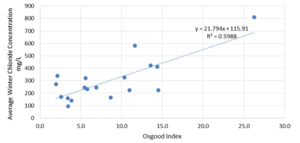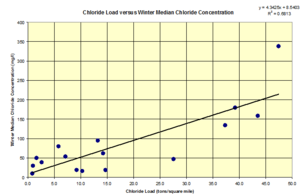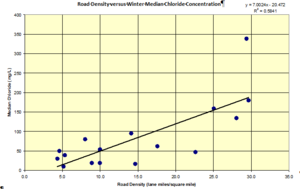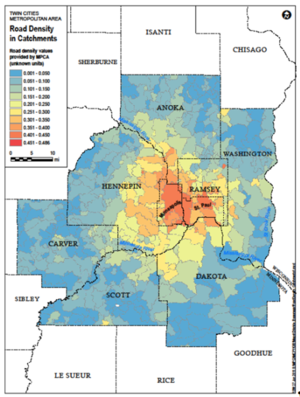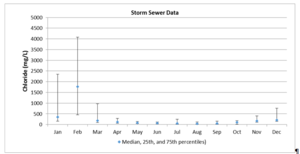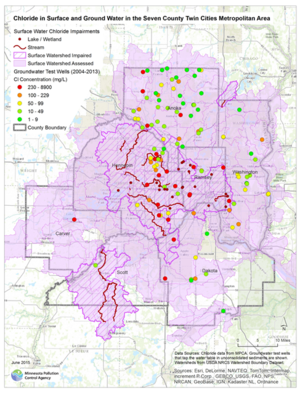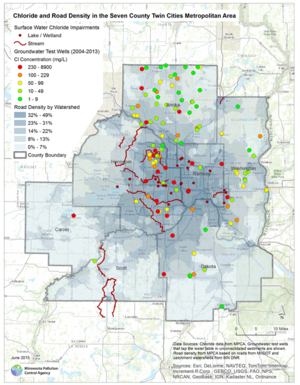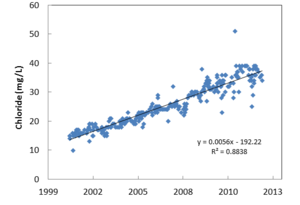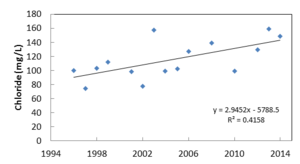
TCMA Chloride Management Plan - TCMA Chloride Conditions
This section of the manual is under construction and will be populated over the next few months. Changes and updates will be posted in the What's new page in the manual. Information on road salt and water quality can be found on MPCA's website
Chloride data across the TCMA was compiled and assessed to support the development of the CMP. As part of the TCMA Chloride Project, the MPCA worked with local partners to develop and implement a chloride monitoring program. The objective of the monitoring program was to better inform an understanding of chloride conditions across the TCMA, including seasonality, trends over time, and the potential for high chloride concentrations in the deepest part of lakes. Seventy-four lakes, 27 streams, and eight storm sewers were monitored as part of this effort from 2010-2013. The Chloride Monitoring Guidance for Lakes and Chloride Monitoring Guidance for Streams and Stormsewers were developed by the MPCA and local experts from the TCMA Chloride MSG and can be found on the MPCA’s TCMA Chloride Project website. The monitoring guidance provides recommendations on sample collection, times of the year to sample, as well as guidance for monitoring high risk waters. In addition to data collected in 2010-2013 following the TCMA Chloride Project monitoring program, chloride data from a host of other sources and timeframes were compiled. The data were collected by several local organizations including the MPCA, the United States Geological Survey (USGS), Capitol Region Watershed District (CRWD), Metropolitan Council Environmental Services (MCES), Minneapolis Park & Recreation Board (MPRB), Minnehaha Creek Watershed District (MCWD), Mississippi Watershed Management Organization (MWMO), Ramsey County Environmental Services, Ramsey-Washington Metro Watershed District (RWMWD), Rice Creek Watershed District, Scott County Watershed Management Organization, and Three Rivers Park District. A large portion of the data were compiled and submitted to the State of Minnesota’s Environmental Quality Information System database (EQuIS). All data collected by Metropolitan Council are available on their Environmental Information Management System (EIMS) database, and data collected by USGS are available on their water-quality data for the Nation database: waterdata.usgs.gov/nwis/qw.
The impacts of climate change create uncertainty related to winter salt application and chloride levels in TCMA waters in the future. Predictions provided by the United States Global Change Research Program for the TCMA area include warmer winter temperatures by 5 - 6 degrees Fahrenheit, longer freeze-free seasons increasing by 20-30 days, greater winter precipitation, and the likelihood of more frequent extreme events (Kunkel et al. 2013). On the one hand, these predictions of climate change may result in reduced salt use. On the other hand, more frequent snow events, more extreme events, and potentially more frequent ice storms may result in greater needs for deicing roads. Continued monitoring of climate change and chloride concentrations in the TCMA waters, tracking of salt use on all paved surfaces, and an adaptive process will be needed to restore and protect the TCMA waters from chloride impairments with the prospects of a changing climate.
The remainder of this section will present an overview of the assessments conducted based on the available data, including determinations of impairment, time and spatial trends in chloride concentrations, the TMDLs developed for impaired waters, and waters showing a high-risk for future impairment.
TCMA Chloride Management Plan - TCMA Chloride Conditions - Condition status
TCMA Chloride Management Plan - TCMA Chloride Conditions - Chloride sources
TCMA Chloride Management Plan - TCMA Chloride Conditions - Chloride trends
Contents
Chloride relationships to watershed and waterbody characteristics
Relationships were evaluated between the average winter chloride concentrations to watershed size, percent impervious surface, lake volume, and the lake Osgood Index. No strong relationships were identified with the exception of the Osgood Index and road density. The Osgood Index relates the mean depth of a lake to the surface area (Osgood Index = Mean Depth (m) ÷ Surface Area (km2)0.5). Lake chloride concentrations generally increase with increasing Osgood Index as shown in the Winter chloride concentrations (November-March) in TCMA lakes versus Osgood Index chart. The Osgood Index may be used to prioritize monitoring efforts for lakes with no or limited data.
Salt applied to impervious surfaces as a deicer is considered a primary source of chloride to lakes and streams. Therefore, one might expect chloride concentrations to be correlated to the amount of impervious area in a watershed. Winter stream chloride concentrations were positively correlated with annual winter salt application (Relationship between road salt load and median winter stream chloride concentration chart). Watersheds with less than 15 tons per square mile of chloride varied in winter stream median chloride concentration ranging from 18 to 89 mg/L (Wenck 2009).
Road density was also positively correlated with median winter chloride concentrations. The deicing salt load was highly dependent on road density (Relationship between road density and median winter chloride concentration chart). Median winter chloride concentrations appear to increase with road densities greater than 25 lane miles per square mile (Wenck 2009). A road density map for the TCMA is presented in the 2010 Road Density in the TCMA map.
Chloride concentrations in stormwater
In comparison to chloride samples taken from lakes, wetlands, and streams, the area’s stormwater runoff contains some of the highest chloride concentrations found in the TCMA. The data indicates a high degree of seasonal variability, which is a result of winter maintenance activities and the direct connection to impervious surfaces. The Storm sewer monthly chloride concentrations chart shows storm sewer chloride data collected in the TCMA from 1980 through 2013. Sample set sizes ranged from 19 to 288 samples per month, for a total of 1,569 samples. The data indicate that high chloride concentrations are found during the winter maintenance season and increase as the winter season progresses with the peak occurring in February
Chloride relationships between surface and groundwater
Concentrations of chloride in shallow groundwater are increasing. Shallow groundwater contributes flow to lakes, wetlands, and streams. In the TCMA, average chloride concentrations in shallow monitoring wells located within watersheds that contain one or more impaired surface waters were higher (141 mg/L) compared to wells in watersheds without an impaired lake, stream, or wetland (48 mg/L) (Chloride in Surface and Ground Water in the TCMA map and Chloride and Road Density in the TCMA map).
Several studies of streams in the Upper Midwest have found that higher chloride levels in shallow groundwater have, in part, contributed to an increase in concentration in streams during low flow conditions, when stream flow is dominated by groundwater inputs (Kelly 2008; Eyles et al. 2013; Corsi et al. 2015). This pattern of increased chloride concentrations during low flow conditions, typically during the summer months, is also evident in streams in the TCMA. Chloride concentrations exceeding the 230 mg/L standard have been observed in Bassett Creek in June and Shingle Creek in August. This issue is not isolated to the TCMA. For example, chloride levels in Miller Creek, a trout stream located in Duluth, have also consistently exceeded the 230 mg/L standard in July and August.
Eagle Creek is located in the city of Savage (Scott County) near the Highway 13/Highway 101 crossroads and is a Class 2A cold-water trout stream, meaning that it is a self-producing trout stream and is primarily fed by groundwater year round. Chloride concentrations have always been below the chronic chloride water quality standard of 230 mg/L; however, chloride concentrations have increased over time. The median chloride concentration in 2012 was 36 mg/L, which is more than twice the median concentration in 2001, 16 mg/L (Increasing chloride concentrations in Eagle Creek from 2001-2012 chart).
Shingle Creek, a tributary to the Mississippi River, is an urban stream that runs through Brooklyn Park, Brooklyn Center, and Minneapolis. The creek typically has numerous exceedances of the 230 mg/L standard each year, particularly during winter months. However, average chloride levels in the stream during summer months have also increased over time (Figure 28). The estimated increase in average summer (July through October) chloride concentration in Shingle Creek from 1996 to 2014 was 53 mg/L, based on a linear regression. The increased chloride concentrations in Eagle and Shingle Creek, and likely many other streams in the TCMA, suggest that chloride from deicing activities is infiltrating into shallow groundwater, resulting in elevated chloride concentrations in streams during summer baseflow conditions.
Similar to other studies (Kelly 2008; Eyles et al. 2013; Corsi et al. 2015), streams in the TCMA and greater Minnesota are experiencing high chloride concentrations during summer baseflow conditions. This trend is attributed to high chloride concentrations in shallow groundwater discharging to streams as baseflow.
Summary of data analysis
Based on the water quality data collected and the above data analyses, the following conclusions can be made:
- Chloride use increased in the TCMA in the latter half of the 20th century, 1950-2000.
- Levels of chloride are continuing to increase in both groundwater and surface waterbodies in the TCMA.
- The highest chloride concentrations occur during snowmelt conditions during winter months and low flow periods in streams.
- Chloride levels tend to be higher in the bottom of a lake versus the surface.
- Chloride concentrations in TCMA waterbodies are positively correlated to road density in the contributing watersheds.
- There are existing data gaps of chloride concentrations in TCMA waterbodies, as many have limited to no data and lack data that would represent critical conditions.
- Winter maintenance activities in urban areas and WWTPs in rural areas tend to be the primary sources of chloride to TCMA waters.
TMDL summary
The Total Maximum Daily Loads (TMDLs) were developed for each of the lakes, wetlands and streams in the TCMA impaired for chloride, with the exception of Shingle Creek and Nine Mile Creek which already have existing TMDLs. A TMDL quantifies the allowable pollutant loading to a lake, wetland, or stream that will result in water quality standards being attained. The water quality target for the TMDLs was set to the chronic water quality criterion for chloride of 230 mg/L. The total allowable load, or TMDL, is allocated to the various sources contributing chloride as well as consideration of a margin of safety and reserve capacity. Margin of safety is intended to account for uncertainty in the development of the TMDL. Reserve capacity is intended to set-aside a portion of the TMDL for future growth. For the TCMA chloride TMDLs, reserve capacity was set to zero assuming that any further development and additional impervious surfaces would be expected to have the same level of best management practices (BMPs) implemented for winter maintenance activities as for the remainder of the watershed. The complete details of the TMDL development are presented in the TCMA Chloride TMDL report (see Appendix A).
A total of 39 waterbodies are listed as impaired by chloride, and TMDLs for Shingle Creek and Nine Mile Creek have already been prepared under separate projects. A total of 37 TMDLs were completed as part of this project. Summaries of the TMDLs are presented in the Summary of TMDL and Components for Impaired Lakes and Wetlands in the TCMA table for lakes and the wetlands and the Summary of TMDL and Components for Impaired Streams in the TCMA table.
Summary of TMDL and Components for Impaired Lakes and Wetlands in the TCMA
Link to this table
| Lake/Wetland | AUID | Watershed Area (ac) | TMDL and Components (all values in lbs/yr of chloride) | |||||
|---|---|---|---|---|---|---|---|---|
| Loading Capacity (TMDL | WLA | LA | Margin of Safety | |||||
| MS4 Categorical | Wastewater Sources1 | Non-Permitted Aggregate | Natural Background | |||||
| Battle Creek Lake | 82-0091-00 | 4,326 | 2,153,699 | 1,766,033 | 0 | 0 | 172,296 | 215,370 |
| Brownie Lake | 27-0038-00 | 452 | 341,418 | 279,963 | 0 | 0 | 27,313 | 34,142 |
| Carver Lake | 82-0166-00 | 2,242 | 1,071,123 | 878,321 | 0 | 0 | 85,690 | 107,112 |
| Como Lake | 62-0055-00 | 1,850 | 994,078 | 815,144 | 0 | 0 | 79,526 | 99,408 |
| Diamond Lake | 27-0022-00 | 744 | 486,017 | 398,534 | 0 | 0 | 38,881 | 48,602 |
| Kasota Ponds North | 62-0280-00 | 10 | 6,234 | 5,112 | 0 | 0 | 499 | 623 |
| Kasota Ponds West | 62-0281-00 | 6 | 5,742 | 4,708 | 0 | 0 | 459 | 574 |
| Kohlman Lake | 62-0006-00 | 7,533 | 4,839,183 | 3,106,733 | 1,050,484 | 0 | 303,096 | 378,870 |
| Little Johanna Lake | 62-0058-00 | 1,703 | 1,224,242 | 1,003,879 | 0 | 0 | 97,939 | 122,424 |
| Loring Pond (South Bay) | 27-0655-02 | 34 | 9,764 | 8,007 | 0 | 0 | 781 | 976 |
| Mallard Marsh | 62-0259-00 | 16 | 9,851 | 8,077 | 0 | 0 | 788 | 985 |
| Parkers Lake | 27-0107-00 | 1,064 | 1,431,262 | 528,161 | 787,163 | 0 | 51,528 | 64,410 |
| Peavey Lake | 27-0138-00 | 776 | 205,995 | 165,889 | 3,692 | 0 | 16,184 | 20,230 |
| Pike Lake | 62-0069-00 | 5,735 | 3,591,268 | 2,943,971 | 1,059 | 0 | 287,217 | 359,021 |
| Powderhorn Lake | 27-0014-00 | 332 | 218,588 | 179,242 | 0 | 0 | 17,487 | 21,859 |
| Silver Lake | 62-0083-00 | 655 | 370,011 | 303,409 | 0 | 0 | 29,601 | 37,001 |
| South Long Lake | 62-0067-02 | 114,785 | 26,334,624 | 21,534,261 | 4,030 | 0 | 2,106,448 | 2,633,059 |
| Spring Lake | 27-0654-00 | 39 | 15,600 | 12,792 | 0 | 0 | 1,248 | 1,560 |
| Sweeney Lake | 27-0035-01 | 2,439 | 1,456,271 | 1,194,142 | 0 | 0 | 116,502 | 145,627 |
| Tanners Lake | 82-0115-00 | 1,732 | 826,520 | 677,746 | 0 | 0 | 66,122 | 82,652 |
| Thompson Lake | 19-0048-00 | 178 | 134,340 | 110,159 | 0 | 0 | 10,747 | 13,434 |
| Valentine Lake | 62-0071-00 | 2,404 | 1,165,072 | 955,359 | 0 | 0 | 93,206 | 116,507 |
| Wirth Lake | 27-0037-00 | 426 | 1,095,000 | 897,900 | 0 | 0 | 87,600 | 109,500 |
1 WLA=0 in the wastewater sources column means that there is no wastewater discharges in that watershed
Summary of TMDL and Components for Impaired Streams in the TCMA
Link to this table
| Stream | AUID | Watershed Area (ac) | TMDL and Components (all values in lbs/yr of chloride) | |||||
|---|---|---|---|---|---|---|---|---|
| Loading Capacity (TMDL | WLA | LA | Margin of Safety | |||||
| MS4 Categorical | Wastewater Sources1 | Non-Permitted Aggregate | Natural Background | |||||
| Bass Creek | 07010206-784 | 5,434 | 1,746,399 | 1,432,047 | 0 | 0 | 139,712 | 174,640 |
| Bassett Creek | 07010206-538 | 25,209 | 9,334,219 | 6,642,961 | 1,233,048 | 0 | 648,094 | 810,117 |
| Battle Creek | 07010206-592 | 7,246 | 2,328,721 | 1,909,551 | 0 | 0 | 186,298 | 232,872 |
| Elm Creek | 07010206-508 | 66,382 | 21,332,410 | 17,386,888 | 0 | 105,688 | 1,706,593 | 2,133,241 |
| Judicial Ditch 2 | 07030005-525 | 1,587 | 510,115 | 418,294 | 0 | 0 | 40,809 | 51,011 |
| Minnehaha Creek | 07010206-539 | 109,151 | 35,997,083 | 28,679,140 | 1,004,128 | 0 | 2,806,140 | 3,507,675 |
| Raven Stream | 07020012-716 | 42,750 | 15,023,193 | 442,771 | 1,284,983 | 10,822,561 | 1,099,057 | 1,373,821 |
| Raven Stream, East Branch | 07020012-543 | 14,751 | 6,025,349 | 442,093 | 1,284,983 | 3,445,007 | 379,229 | 474,037 |
| Rush Creek, South Fork | 07010206-732 | 13,844 | 4,470,069 | 3,646,696 | 21,010 | 1,532 | 355,925 | 444,906 |
| Sand Creek (South) - includes 07020012-662 | 07020012-513 | 175,578 | 59,480,179 | 4,402,547 | 3,056,425 | 41,864,932 | 4,513,900 | 5,642,375 |
| Unnamed creek (Headwaters to Medicine Lk) | 07010206-526 | 6,447 | 2,071,959 | 1,699,006 | 0 | 0 | 165,757 | 207,196 |
| Unnamed creek (Unnamed ditch to wetland) | 07010206-718 | 793 | 254,852 | 208,979 | 0 | 0 | 20,388 | 25,485 |
| Unnamed Stream (Unnamed lk 62-0205-00 to Little Lk Johanna) | 07010206-909 | 1,627 | 522,817 | 428,710 | 0 | 0 | 41,825 | 52,282 |
1 WLA=0 in the wastewater sources column means that there is no wastewater discharges in that watershed
Protection of surface and groundwater
Protection is an opportunity to prevent waters from continued degradation which may result in impairment. Prevention or protection is often more easily accomplished than the restoration of an impaired waterbody. Protection efforts also may eliminate the need for additional permit and other regulatory requirements to reduce pollution. Successful protection efforts rely on understanding how current practices or conditions may be contributing to water quality conditions.
High risk surface waters
Preventing a waterbody from being contaminated with chloride is easier and more cost effective than restoration. Chloride is a conservative ion and will not break down over time but rather it accumulates in waters. Therefore, efforts should be made to protect waters that show an increasing trend in chloride concentration or have been shown to have chloride concentrations approaching the water quality criteria. Lakes, wetlands, or streams with at least one sample within 10% of the chronic water quality standard within the last 10 years have been identified as a high risk waterbody (one exceedance of 207 mg/L chloride). Proactive actions to reduce chloride loads to these high risk waterbodies should be pursued. Proactive actions similar to actions listed for impaired waters should be explored to protect high risk waters. These waters are considered to be approaching the water quality standard and if no actions are taken, they will likely reach impairment status in the near future. The TCMA lakes and streams identified as being at high risk for potential chloride impairment are shown in the High Risk Lakes in the TCMA table and the High Risk Streams in the TCMA table, respectively.
It should be noted that there are potentially many more high risk waters in the TCMA that have not been identified because there is limited or no monitoring data available for those waters. For this reason, similar proactive approaches to chloride management should be taken to prevent chloride contamination.
All surface waters and groundwater
In addition to the high risk waters listed above, protecting all surface waters and groundwater from further degradation due to chloride is important. By implementing salt reducing practices throughout the TCMA, both the need to restore those waters already impaired and also protect those waters not yet exceeding the standard are addressed. The practices necessary for protection of groundwater are the same as those for restoring and protecting surface waters. Through targeting and prioritization a starting point can be established. Management practices and BMPs used for impaired and high risk waters can be the same for all waterbodies and should provide the same level of protection and chloride reduction.
High risk lakes in the TCMA
Link to this table
| Lakes | AUID |
|---|---|
| Beaver Lake | 62-0016-00 |
| Bennett Lake | 62-0048-00 |
| Calhoun Lake | 27-0031-00 |
| Centerville Lake | 02-0006-00 |
| Crosby Lake | 62-0047-00 |
| Crystal Lake | 27-0034-00 |
| Fish Lake | 19-0057-00 |
| Gervais Lake | 62-0007-00 |
| Hiawatha Lake | 27-0018-00 |
| Johanna Lake | 62-0078-00 |
| Keller Lake (Main) | 62-0010-02 |
| Lake Of The Isles | 27-0040-00 |
| McCarron Lake | 62-0054-00 |
| Medicine Lake | 27-0104-00 |
| Ryan Lake | 27-0058-00 |
| Taft Lake | 27-0683-00 |
| Unnamed Lake | 62-0278-00 |
| Wabasso Lake | 62-0082-00 |
| Wakefield Lake | 62-0011-00 |
High risk streams in the TCMA
Link to this table
| Streams | AUID |
|---|---|
| Bevens Creek | 07020012-718 |
| Bluff Creek | 07020012-710 |
| Classen Lake Creek | 07010206-703 |
| Clearwater Creek | 07010206-519 |
| County Ditch 17 (Spring Brook) | 07010206-557 |
| Credit River | 07020012-517 |
| Diamond Creek | 07010206-525 |
| Dutch Lake Outlet | 07010206-678 |
| Fish Creek | 07010206-606 |
| Painter Creek | 07010206-700 |
| Rush Creek | 07010206-528 |
| Unnamed Creek | 07010206-704 |
| Unnamed Creek | 07010206-740 |
| Unnamed Creek (Pleasure Ck) | 07010206-594 |
| Unnamed Stream (Perro Ck) | 07030005-612 |
| Unnamed Stream (Sand Ck) | 07010206-744 |
| Unnamed Stream (Trib To Long Lk) (Furgala Creek) | 07030005-765 |
| Unnamed Stream In Plymouth | 07010206-738 |
| Unnamed Stream Receiving Wtr From Medicine Lk | 07010206-785 |
